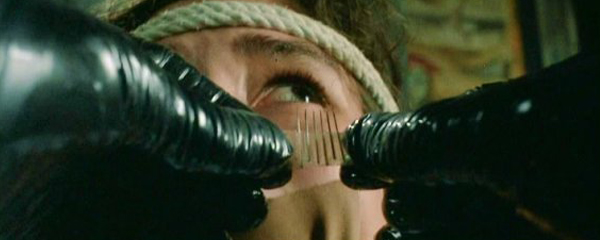by Matthew Robinson
"I'm Dario Argento, and my style is something recognizable I think by the audience."
A unique film import seeped into American cinemas in the late 1960s and throughout the 1970s: Giallo, an Italian subgenre of horror consisting of extreme bloodletting, stylish filmmaking, and an attention to musical placement. This style of film was so distinct that it forced film scholars to examine the wave of filmmakers coming out of Italy at the time. Giallo’s influence is alive today with filmmakers like Quentin Tarantino and Brian DePalma making direct reference to this lush style of horror. But to fully understand Giallo, one must look at a film's overall style, form, and thematic elements, as well as some of the major works within the genre.
WHAT IS A GIALLO FILM?
Suspira (1977)
While it is difficult to specifically pinpoint what constitutes a Giallo film, there are some identifying aspects of the subgenre that help define it. The first is the film’s overall feel and style, the cornerstone of all Giallo films. Many Giallo films focus on extreme bloodletting during death sequences, which play out as operatic and ornate centerpieces and are labored over on a technical level. Acute attention is given to the sets, props, cinematography, and editing of these bloodletting scenes, making them feel intricate and surreal to the viewer. In contrast, today’s horror films tend to focus on shocking viewers during death scenes through quick jumps and rapid thrills.
Another style aspect of the Giallo subgenre is the film’s shooting location and the actors’ wardrobe. Many Giallo films feature Italian landmarks and other famous scenery to promote the film’s Italian origins. Actors wear costumes reflective of the era’s fashion. The film’s killer almost always dons a black trench coat and black gloves with a covered face. The setting for the film’s murders is often tied to the film’s fashion as well. The dresses and makeup worn by the women within Giallo films tends toward the highly stylish.
Blood and Black Lace (1964)
Giallo films use several elements of form including gorgeous cinematography, stylized editing, and the important placement of music. Visual flare characterizes the elaborate death scenes and adds beauty to the locales. The moody lighting and slow camera moves lend an atmosphere of fear and dread. Many Giallo films deal with mental illness and visually contain surreal and psychedelic flares. Technically, the camera moves are intricate and precise, often using mobile framing. Several Giallo films, such as Dario Argento’s Opera, are noted for long tracking shots and extremely daring crane shots. The editing is highly stylized and features quick cuts that create a frantic feeling during murder scenes, often in stark contrast to the languid pace of the rest of the film’s narrative. The editing may include jump and non-linear cuts to help create the aforementioned surreal and psychedelic moments.
The music of Giallo films plays a vital role. The film’s killer is often given his own theme music, and murder scenes may feature the same song played over them. The use of rock music was unique at the time these films were first produced. Dario Argento most famously worked with Goblin on several of his films by weaving their unique and heavy electronic rock sound into his murder scenes.
Tutti i colori del buio (1972)
Several thematic elements can be found within all Giallo films. The male killer and lead female protagonist may suffer from mental illness. The female lead is often the only witness to the film’s murders, which causes her psychotic episodes or the mention of seeking or needing therapy. Giallo films may also contain disturbing dream sequences or hallucinations. Tourism is another common element. In addition to the use of Italian landmarks and/or other famous site locations, the lead character is often a tourist in an unfamiliar setting. In some instances, the films will take short asides to highlight this, such as a day-trip to the countryside. Finally, repressed childhood memories frequently drive the killer to murder others, and this may be repeatedly shown throughout the film in broken flashbacks.
An Introduction to Giallo
While there are many ways one could get into this sub-genre, I will suggest three films to begin with as well as some further recommendations. While these three films do not all represent the best that Giallo has to offer, they do offer a well-rounded entry point into the works of three prolific directors (Mario Bava, Lucio Fulci, and Dario Argento).
The following films exemplify the signature traits of a Giallo film: Blood and Black Lace, Don’t Torture a Duckling, and Opera.
Blood and Black Lace
Mario Bava’s Blood and Black Lace (1964) is often credited as the first Giallo film, and its influence is evident a decade following its release. The film opens with a beautiful young model being murdered by a mysterious masked figure outside the fashion house where she works. When her boyfriend is suspected of her killing, her diary, which contains incriminating evidence linking her to the killer, vanishes. The masked killer goes on a rampage, killing many of the models in the fashion house to find the diary and keep his identity a secret. With its overwhelmingly stylish and chic design and its attention to beautiful women falling victim to a black gloved, sadistic lunatic in a trench coat, Blood and Black Lace is a first of its kind film. However, Bava throws the film’s plot and characters too far into the background, from which the movie suffers. While individual scenes are visually fantastic -- primarily the kill scenes due to the film’s effective pacing and dynamic visuals -- the film as a whole lacks any real mystery. The story is too thin to allow the audience to play along in figuring out the murderer’s identity. However, the film does deserve credit for defining the Giallo killer’s appearance. The black gloves, masked face, and trench coat worn by the killer are particularly effective. Bava frequently directs the killer to emerge from the shadows, using colored gel lights to cast a burst of red onto the murderer. This effect is eerie and creepy, and one can quickly see why it had such a defining influence on the Giallo subgenre.
Dont Torture a Duckling
Don’t Torture a Duckling (1972) is one of Lucio Fulci’s best movie titles as well as one of his better films. The film deals with the mysterious deaths of three children in a small, rural town. The opening shots of Fulci’s film are gorgeous panoramic views of the rolling hills of the Italian countryside. After these initial opening shots, Fulci’s camera pans over to a woman who is desperately clawing at the ground, unearthing the skeletal remains of a baby. While the meaning of this scene is vague, the audience soon discovers that several children in the town have gone missing. The town is ready to take action to find the kidnapper. Fulci creates a “whodunit” that is interesting and far from dull. Don’t Torture a Duckling is a fantastic Giallo; it maintains its mystery by lingering on clues and revelations just long enough to make the film’s horror moments effective. It’s also one of the rare instances where Fulci seems to care for his female protagonist, in stark contrast to his more misogynistic films like New York Ripper (1982). There is an influential scene in the film where a woman is beaten to death by chains and sticks. The film’s brutality is juxtaposed nicely with the serene countryside on a sunny afternoon, and energetic soul music plays on a radio overhead. This mixture of violence and contemporary music feels fresh, and it's clear that this film has significantly influenced other directors, notably Quentin Tarantino.
Opera
Dario Argento’s oft-overlooked stunner Opera (1987) features the director’s most daring camerawork and dynamic pacing of his impressive career. Opera contains a number of astonishing technical achievements. In fact, one incredible, “How did they do that?” crane shot circling the large opera house flying over the patron’s head is truly something that must be seen to be believed. The film follows Betty, an understudy who gets her big break when the play’s lead is run over by a car. But after her performance, a masked and gloved killer forces her to watch him as he murders someone else. Betty becomes paranoid with fear, and her sanity is questioned over the duration of the film. A detective begins searching for the killer, and Betty continues to be forced into watching the murders of everyone around her. Argento’s style is in full form here and the film is both effective and a technical achievement. The camera constantly creeps around the opera house, a perfect setting for Argento, using dolly shots to suggest the killer is omnipresent. The setting also allows for a lavish display of costumes and set design. The film is a visual feast for viewers. Colored lighting is heavily used to suggest Betty’s sanity slipping and is one of the director’s trademarks.
Giallo's Influence
Brian De Palma's Dressed to Kill (1980)
Giallo films had a relatively short lifespan in the 1960s and 1970s, but out of that time came some truly original work. Directors like Mario Bava, Dario Argento, and Lucio Fulci took risks, stylizing their films with chic costumes, grand sets, and bold camera moves. Their influence can be seen today in directors like Quentin Tarantino and especially Brian De Palma. Giallo may be a subgenre relegated to cult status, but its influence is widespread. The American slasher film would not exist, nor would Italian thrillers contain as much style without these films. The elements that make a film Giallo also make them stand out today as films that deserve more attention. While the genre holds its fair share of treasure and trash, Mario Bava’s Blood and Black Lace, Lucio Fulci’s Don’t Torture a Duckling, and Dario Argento’s Opera are three of the finest examples of the subgenre.
Other Key Giallo Films:
• A Bay of Blood or Twitch of the Death Nerve
• Short Night of Glass Dolls
• All The Colors of the Dark
• Deep Red
• Lizard in a Woman’s Skin
• The House with Laughing Windows
• What Have You Done to Solange?
• Tenebre
• Dressed to Kill








